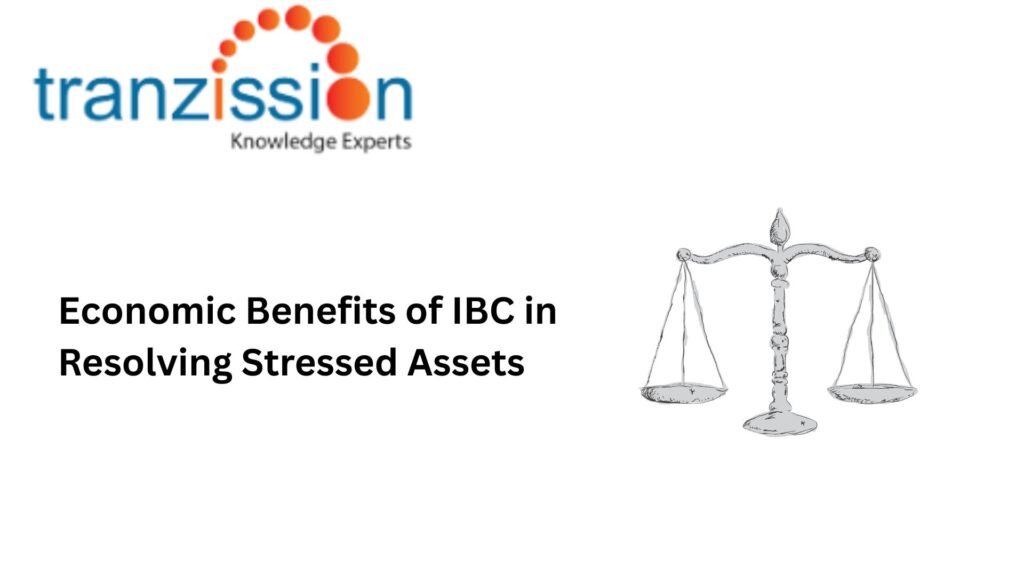
Economic Benefits of IBC in Resolving Stressed Assets

Table of Contents
Economic Benefits of IBC in Resolving Stressed Assets is a financial asset, like a loan, bond, or investment, where the borrower or owner is struggling to meet their obligations or generate expected income. There are several types of stressed assets:
- Non-performing assets (NPAs): Loans or advances where the borrower has failed to make payments for a defined period, which is typically 90 days or more.
- Restructured loans: Loans where the original repayment terms, interest rate, repayment schedule, have been modified due to the borrowers financial difficulties.
- Written-off assets: Loans deemed irrevocable and removed from the banks books.
Stressed assets, like NPAs, significantly impact the banking sector and the overall economy. They reduce the banks profitability, lower capital adequacy, and increase the risk aversion, thereby leading to slower credit growth and potentially higher interest rate. These effects can negatively affect economic activity, investment, and overall stability.
Genesis of the Insolvency and Bankruptcy Code
The previous insolvency framework was fragmented and inefficient, with multiple laws governing different types of insolvency. For instance, the applicability of the Sick Industrial Companies (Special Provisions) Act, 1985 (SICA) was criticized for its slow and cumbersome processes, which often delayed resolution and exacerbated losses. The Indian banking sector was also struggling with a significant amount of bad loans which hindered financial stability and economic growth. To address these issues, the Ministry of Finance established the Bankruptcy Legislative Reforms Committee (BLRC) on August 22, 2014.
The BLRC was tasked with drafting a new bankruptcy law that would consolidate existing provisions and establish a more streamlined and efficient resolution process, and submitted its report in November 2015. The Insolvency and Bankruptcy Code, 2016 (“the IBC) consolidated various laws related to insolvency and bankruptcy, repealing the Presidency Towns Insolvency Act, Provisional Insolvency Act, and SICA. It introduced a time-bound corporate insolvency resolution process (CIRP), with a stipulated timeline for resolving corporate insolvency cases. The IBC aimed to facilitate quicker and more effective recovery of dues for creditors, including banks and financial institutions, by providing a more streamlined process. Essentially, it sought to balance the interests of various stakeholders, including creditors, debtors, and employees, ensuring a fair and equitable resolution process.
Read more : Legal consequences of misrepresentation in insolvency petitions
Economic Benefits of IBC in Resolving Stressed Assets:
The Economic Benefits of IBC offers significant by facilitating faster resolution of stressed assets:
-
Enhanced Recovery Rates for Creditors: The efficiency of the IBC minimises delays and reduces the impact of stressed assets on the economy. Thus, it has demonstrated improved recovery rates for creditors.
-
Time-Bound Resolution Process: The IBC mandates a time-bound resolution, which is significantly faster than the pre-IBC framework. Section 12 mandates that the CIRP be completed within 330 days from the application’s admission date, including extensions. This time constraint aims to prevent asset value erosion, provide certainty to stakeholders, and facilitate efficient debt resolution.
- Improved Credit Discipline: By establishing a clear and a predictable framework for insolvency, the IBC instilled a greater sense of responsibility among both borrowers and lender, thereby, reducing NPAs and boosting investor confidence.
-
Revival of Viable Businesses: The IBC focuses on resolution, which helps job losses and maintains economic stability, as the business continues operating. Hence, it strengthens the overall economy by promoting job preservation and a more stable and efficient business environment.
-
Attraction of Domestic and Foreign Investment: The IBC has made India a more attractive destination for both domestic and foreign investment by streamlining the resolution process. Its reforms contribute to the insolvency framework integration into the global business landscape, making it easier for businesses to trade and invest internationally. The increased investor confidence due to transparent processes, and boosts in mergers and acquisitions activities.
-
Reduction in Non-Performing Assets: The implementation of the IBC has significantly contributed to the decline in NPAs, strengthening the banking sector’s health. Statistical data indicates a notable reduction in both gross and net NPAs, with a significant portion of recoveries being achieved through the IBC mechanism.
-
Improved Ease of Doing Business: The IBC has demonstrably improved India’s global rankings and created a more conducive business environment. By streamlining insolvency resolution and reducing NPAs, the IBC has boosted investor confidence and improved India’s in global indices like the World Bank’s Ease of Doing Business Index.
Challenges and Areas for Improvement
The IBC, while a significant reforce, faces several challenges:
- There are numerous statutory and procedural hurdles that delay the entire insolvency process.
- The National Company Law Tribunal (NCLT) faces a backlog of cases, contributing to delays and exacerbating the issue of timely resolution.
- While the IBC aims to balance the interests of all stakeholders, recovery rates for operational creditors are often low.
- The absence of a comprehensive cross-border insolvency framework poses challenges in dealing with cases involving foreign creditors and assets.
Future Outlook on Economic Benefits of IBC
To streamline the resolution process, enhance stability, and boosts economic growth, reforms have been suggested:
- Focusing on faster resolution through quicker admission, streamlined processes, and clearer timelines can expedite the resolution process.
- Increasing the number of courts, benches, and members in the NCLT can improve case disposal rates and reduce backlogs.
- Implementing digital case management systems and automating processes can enhance efficiency and accuracy.
- The Insolvency and Bankruptcy Board of India (IBBI) can introduce training programs for insolvency professionals, legal experts, and corporate managers can enhance their understanding and application of the IBC .
- Addressing cross border insolvency issues through measures like adopting the UNCITRAL Model Law can enhance the effectiveness of the IBC in managing complex cases.
Conclusion : Economic Benefits of IBC
By providing a structured framework for resolving stressed assets, the Economic Benefits of IBC promotes growth. It facilitates the systematic identification and resolution of stressed assets, allowing banks to clean up their balance sheets and reduce their NPAs. This frees up capital that can be used for lending to productive sectors of the economy. Thus, the IBC is a vital tool for promoting economic growth in India by resolving stressed assets, attracting investment, and facilitating the revival of distressed companies.





